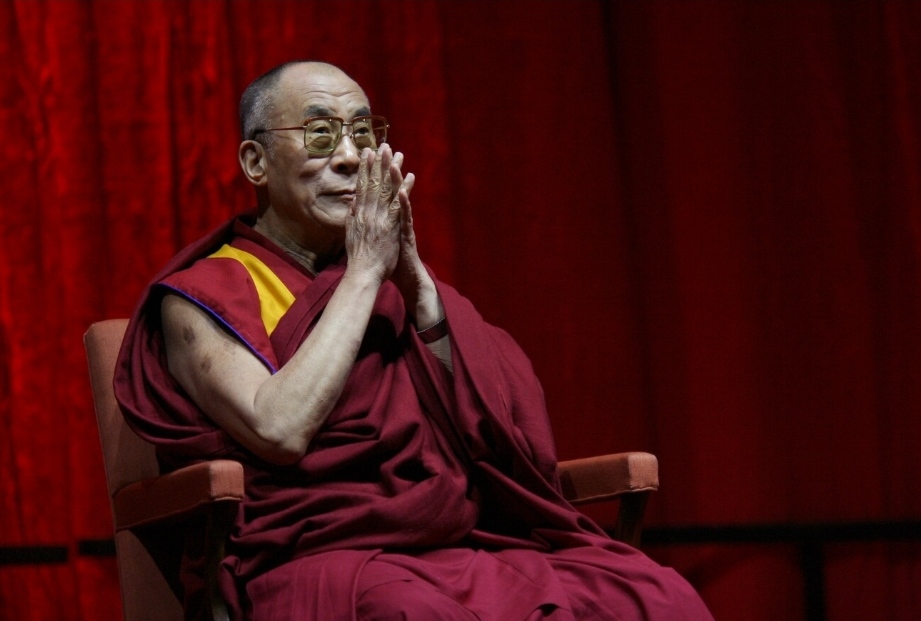Only Dalai Lama will decide his successor

File Image: The Dalai Lama Via Wikipedia
Tibet is an ancient Country nestled between India and China. For the people of Tibet, His Holiness the Dalai Lama is the manifestation of Chenrezig, or Avalokitesvara, the Bodhisattva of Compassion. Successive Dalai Lamas have held spiritual and temporal power over the Tibetan Buddhist Kingdom for 400 years.
Buddhists from the Himalayan belt and beyond revere the Dalai Lama as their spiritual leader and share solid karmic bonds. To others, the Dalai Lama is an inspiration and is regarded as a leading moral authority worldwide.
By 1958 due to Indian apathy, Communist China invaded Tibet and captured it completely. His Holiness Dalai Lama escaped to India and a Tibetan Government in Exile was established at Dharamshala in Himachal Pradesh. However Tibetans since then have been waging a non violent campaign to throw out the Chinese Army out of Tibet.
In recognition of his non-violent campaign to end China’s rule in Tibet, the Norwegian Nobel Committee awarded the most prestigious Nobel Peace Prize to the 14th Dalai Lama on December 10, 1989, in Oslo, Norway.
This recognition presented an excellent opportunity for Tibetans to reignite the China-Tibet conflict as an unresolved political issue that required global attention and continued support.
For the next two decades or so, the spiritual and temporal leader of the Tibetan people traveled extensively throughout the world — reaching out to political leaders, heads of many States, parliamentarians, policymakers, religious chiefs, media organizations, universities, scholars, writers, celebrities, activists and many more to garner political and practical support for Tibet and the Tibetan people.
At the same time, the Nobel Peace laureate reached out to leaders in Beijing for a mutually acceptable outcome to bring about lasting peace and security for the Tibetan and the Chinese people through a negotiated settlement.
China’s brutal dictator Mao Tsetung ordered his PLA troops to invade Tibet in 1950. Over a million Tibetans died as a direct result of China’s illegal occupation. Beijing took complete control of the peaceful Buddhist nation after the 24-year-old Dalai Lama fled to India in March 1959, where he was given political asylum.
“Government-in-Exile” And Tibetan Democracy
After establishing Tibet’s “Government-in-Exile” (or Central Tibetan Administration), the young Dalai Lama continued to promote the democratic reforms for his people, which he had sought to implement in Tibet before being forced to flee in 1959.
Today, based in Dharamsala, northern India, the Central Tibetan Administration continues to carry out its mission of securing political freedom for Tibetans in Tibet while taking care of its refugee community.
During an early public gathering in February 1960 in Bodh Gaya, where the Lord Buddha achieved enlightenment, the Dalai Lama advised the exiled Tibetans to set up an elected body.
The Commission of Tibetan People’s Deputies (CTPD) took its first oath on September 2, 1960. Since then, this historical date has been observed by the Tibetan diaspora as Mang-tso Dus-chen — Tibetan Democracy Day.
The final stage of this democratization process was achieved when the Dalai Lama voluntarily relinquished his remaining political authority to the elected Tibetan leadership in 2011 after a young Tibetan legal scholar from Harvard University, Dr. Lobsang Sangay, had secured a landslide victory in the general election. Dr Sangay held the highest Office of Sikyong (formerly Kalon Tripa) for two consecutive terms until 2021.
Full retirement from the Tibetan political leadership meant the Dalai Lama reduced his international travels and political engagements with world leaders. At 88, the Dalai Lama remains very healthy and joyful as always, and above all, His Holiness continues to deal with a busy daily schedule of public and private engagements.
Over this summer (2023), the Dalai Lama visited Ladakh, near the India-Tibet border, where he stayed for a month and gave Buddhist teachings to tens of thousands of his followers.
Public support for the Dalai Lama in this and other parts of the Himalayan belt, including Tawang in Arunachal Pradesh, is rock solid. One of his predecessors, the 6th Dalai Lama, Tsangyang Gyatso (1693 – 1706), was born in Monyul, Tawang.
The current Dalai Lama has visited this historic Buddhist region of Monpas many times. Tawang was the first Indian town where the Dalai Lama was welcomed by the Indian authorities after he escaped from Tibet in March 1959.
The region, also claimed by the People’s Republic of China, has once again become a border hot spot with tension between Beijing and New Delhi after Chinese troops recently crossed into Indian territory.
The Dalai Lama’s Succession And The Tibet Question
As his age advances, governments, parliaments, think tanks and media houses have been taking a deep interest in the succession of the current 14th Dalai Lama. The Tibetan Buddhist leader has previously stated that when he reaches around 90, some news about his successor will be revealed.
The Dalai Lama has also repeatedly stated that he envisions living around 113 years. Scholars and researchers from Australia, Austria, Belgium, the Czech Republic, Finland, France, India, Japan, Mongolia, Poland, Sweden, Taiwan, the UK, and the US have been studying the possible implications of the post-Dalai Lama era.
In May 2023, “The Dalai Lama’s Succession: Strategic Realities of the Tibet Question,” a joint publication of the Stockholm Center for South Asian and Indo-Pacific Affairs (SCSA-IPA) of the Institute for Security & Development Policy (Sweden) and the Organisation for Research on China and Asia (ORCA, India), is probably the first in-depth research paper made publicly available.
This major issue for the Tibetan Buddhist world has geo-political implications. Many noted experts and researchers from across the world have contributed to this Special Paper, edited by distinguished scholars — Jagannath P. Panda, Head of the Stockholm Centre for South Asian and Indo-Pacific Affairs; and Eerishka Pankaj, Director, Organisation for Research on China and Asia (ORCA).
The scholarly work, which reveals some penetrating insights into the post-Dalai Lama era, requires close attention and preparation by all major stakeholders.
Unsurprisingly, Beijing has closely monitored this development for some considerable time. It passed Order No.5 – ‘Management measures for the reincarnation of living Buddhas in Tibetan Buddhism’ – at the State Administration of Religious Affairs administrative affairs conference on July 13, 2007.
The Order shows a clear intent on the part of Communist China to interfere in the Dalai Lama’s reincarnation, a tradition Tibetan Buddhists have continued for centuries and which has no relevance to the People’s Republic of China, which came into existence only in 1949.
In his article titled, “The Battle for the Soul of the Dalai Lama – To Control Tibet, Communist China Ventures Into the Spiritual Realm,” published in the Foreign Affairs Magazine earlier this month, Dr Lobsang Sangay, Lecturer at Harvard Law School and former President of the Central Tibetan Administration, writes: “The norms of the Tibetan Buddhist tradition of reincarnation and the Dalai Lama’s stance on his reincarnation must steer the process of determining any future succession.
“Following that tradition, instructions the Dalai Lama leaves before his death should be the basis of any search to identify his successor. Beijing, however, wants to usurp both spiritual and temporal authority in Tibet.
“The Chinese government’s transgressions are legion, including legislative interference, historical revisionism, and the outright denial of the Dalai Lama’s fundamental right to guide the choice of his successor. Along with the government’s broader efforts to suppress Tibetan culture, China’s actions constitute a grave violation of the basic human rights of the Tibetan people.”
Speaking at recent Tibetan gatherings, the Dalai Lama stated that his hope of bestowing Buddhist teachings to fellow Tibetans in Tibet in front of the Potala Palace, which has been the official residence of the Dalai Lama for centuries, is expected to materialize “soon.”
The Tibetan spiritual leader and Sikyong Penpa Tsering, the incumbent President of the Central Tibetan Administration (CTA), have also stated recently that individuals affiliated with the Chinese Communist leadership in Beijing have been in contact with the Dalai Lama through backdoor channels.
Given the rapid geo-political developments, especially since the pandemic, this backdoor communication channel between Beijing and Dharamsala is unsurprising. Beijing has been scheming its next great move for some time.
We ought to remember the last “official talks,” held between the envoys of the Dalai Lama and China’s representatives, from 2002 to 2010, ended only after Beijing flatly rejected the Tibetan leader’s proposal in his ‘Memorandum on Genuine Autonomy for the Tibetan People’ after nine rounds of formal, but fruitless, dialogue.
In June 2012, Reuters quoted the joint resignation letter by former envoys of the Dalai Lama – Special Envoy Lodi Gyari and Envoy Kelsang Gyaltsen – in which the duo said, “Given the deteriorating situation inside Tibet since 2008 leading to the increasing cases of self-immolations by Tibetans, we are compelled to submit our resignations.
“Furthermore, the United Front did not respond positively to the ‘Memorandum on Genuine Autonomy for the Tibetan people’ presented in 2008 and its Note in 2010. One of the key Chinese interlocutors in the dialogue process even advocated abrogation of the minority status as stipulated in the Chinese constitution, thereby seeming to remove the basis of autonomy. At this particular time, it is difficult to have a substantive dialogue”.
During a recent interview with Tsering Kyi on Voice of America (VOA), Tenzin Norgay, Research Analyst at the International Campaign for Tibet (ICT), Washington DC, echoed this mooted change in the Chinese constitution, which could impact the Dalai Lama’s “Middle-Way” proposal.
Norgay said: “If the PRC removes the Regional Autonomy rights, as currently stipulated in the Chinese constitution for China’s minorities, which also includes the Tibetans, then this leaves no basis for the Central Tibetan Administration to pursue the Dalai Lama’s Middle-Way policy.”
Speaking about a precedent for changing China’s constitution, the Tibetan analyst added: “Beijing amended its constitution in recent years to accommodate Xi Jinping’s desire to stay in power beyond the previous two five-year fixed terms.”
After Xi Jinping came to power in 2013, Beijing invested billions of dollars to drive his expansionist ambition through China’s Belt & Road Initiative (BRI). Intended to be a “win-win” strategy for participating countries, Xi’s regime is already proving a growing enemy to “debt-trapped” poorer nations while posing a real security threat at regional and global levels.
The “de-risking” strategy — considered by many nations, which would include the reduction of investments and moving multinational companies out of China, has a solid connection to Beijing’s cover-ups during the COVID-19 pandemic, global goods supply chains, and geopolitical and other security issues.
Key stakeholders, including the Tibetan leadership in India, need to learn lessons when dealing with the Chinese regime that has exerted power since 1950. Communist rulers pursue various means to secure their “interests.”
One firm, and probably the only card the Tibetans-in-Exile have still retained on their side for Tibet’s future, is the present 14th Dalai Lama, who currently lives in a free and democratic country.
Gifting his succession to the court of the Chinese Communist regime would not only be fatal to the centuries-old Tibetan Buddhist tradition. Still, it would serve China’s aim to gobble up Tibet and exterminate Tibetans’s unique identity while alienating friends and allies of Tibet in India and beyond.
China’s cynical move to interfere in the Dalai Lama’s succession needed to be ridiculed. It was George Orwell, in his essay Shooting an Elephant, who stated that the one thing despotic rulers fear is ridicule.
China’s CCP is avowedly hostile to religion. “Religion is poison” was Mao’s private remark to the Dalai Lama during his visit to China in 1954. There is no place for the Communist Party of China to interfere in the religious beliefs and practices of other people.




